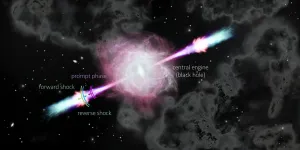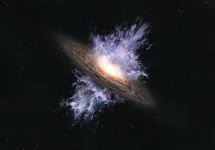(Press-News.org) An international team of scientists, led by astrophysicists from the University of Bath in the UK, has measured the magnetic field in a far-off Gamma-Ray Burst, confirming for the first time a decades-long theoretical prediction - that the magnetic field in these blast waves becomes scrambled after the ejected material crashes into, and shocks, the surrounding medium.
Black holes are formed when massive stars (at least 40 times larger than our Sun) die in a catastrophic explosion that powers a blast wave. These extremely energetic events drive out material at velocities close to the speed of light, and power bright, short-lived gamma-ray flashes that can be detected by satellites orbiting the Earth - hence their name, Gamma-Ray Bursts (GRBs).
Magnetic fields may be threaded through the ejected material and, as the spinning black hole forms, these magnetic fields twist into corkscrew shapes that are thought to focus and accelerate the ejected material.
The magnetic fields can't be seen directly, but their signature is encoded in the light produced by charged particles (electrons) that whiz around the magnetic field lines. Earth-bound telescopes capture this light, which has travelled for millions of years across the Universe.
Head of Astrophysics at Bath and gamma-ray expert Professor Carole Mundell, said: "We measured a special property of the light - polarisation - to directly probe the physical properties of the magnetic field powering the explosion. This is a great result and solves a long-standing puzzle of these extreme cosmic blasts - a puzzle I've been studying for a long time."
CAPTURING THE LIGHT EARLY
The challenge is to capture the light as soon as possible after a burst and decode the physics of the blast, the prediction being that any primordial magnetics fields will ultimately be destroyed as the expanding shock front collides with the surrounding stellar debris.
This model predicts light with high levels of polarisation (>10%) soon after the burst when the large-scale primordial field is still intact and driving the outflow. Later, the light should be mostly unpolarised as the field is scrambled in the collision.
Mundell's team was first to discover highly polarised light minutes after the burst that confirmed the presence of primordial fields with large-scale structure. But the picture for expanding forward shocks has proved more controversial.
Teams who observed GRBs in slower time - hours to a day after a burst - found low polarisation and concluded the fields had long-since been destroyed, but could not say when or how. In contrast, a team of Japanese astronomers announced an intriguing detection of 10% polarised light in a GRB, which they interpreted as a polarised forward shock with long-lasting ordered magnetic fields.
Lead author of the new study, Bath PhD student Nuria Jordana-Mitjans, said: "These rare observations were difficult to compare, as they probed very different timescales and physics. There was no way to reconcile them in the standard model."
The mystery remained unsolved for over a decade, until the Bath team's analysis of GRB 141220A.
In the new paper, published today in the Monthly Notices of the Royal Astronomical Society, Professor Mundell's team report the discovery of very low polarisation in forward-shock light detected just 90 seconds after the blast of GRB 141220A. The super-speedy observations were made possible by the team's intelligent software on the fully autonomous robotic Liverpool Telescope and the novel RINGO3 polarimeter - the instrument that logged the GRB's colour, brightness, polarisation and rate of fade. Putting together this data, the team was able to prove that:
The light originated in the forward shock.
The magnetic field length scales were much smaller than the Japanese team inferred.
The blast was likely powered by the collapse of ordered magnetic fields in the first moments of the formation of a new black hole.
The mysterious detection of polarisation by the Japanese team could be explained by a contribution of polarised light from the primordial magnetic field before it was destroyed in the shock.
Ms Jordana-Mitjans said: "This new study builds on our research that has shown the most powerful GRBs can be powered by large-scale ordered magnetic fields, but only the fastest telescopes will catch a glimpse of their characteristic polarisation signal before they are lost to the blast."
Professor Mundell added: "We now need to push the frontiers of technology to probe the earliest moments of these blasts, capture statistically significant numbers of bursts for polarisation studies and put our research into the wider context of real-time multimessenger follow-up of the extreme Universe."
INFORMATION:
Researchers using the Atacama Large Millimeter/submillimeter Array (ALMA) discovered a titanic galactic wind driven by a supermassive black hole 13.1 billion years ago. This is the earliest-yet-observed example of such a wind to date and is a telltale sign that huge black holes have a profound effect on the growth of galaxies from the very early history of the Universe.
At the center of many large galaxies hides a supermassive black hole that is millions to billions of times more massive than the Sun. Interestingly, the mass of the black hole is roughly proportional to the mass ...
The old cousins of the common woodlice were crawling on Irish land as long as 360 million years ago, according to new analysis of a fossil found in Kilkenny.
The research, published today (00.01 Wednesday 16 June) in the science journal Biology Letters, used state-of-the-art modern imaging technology to create a new picture of the Oxyuropoda - a land-based creature larger than the modern woodlice - using a fossil found in Kiltorcan, Co Kilkenny in 1908.
Lead researcher Dr Ninon Robin, a postdoctoral researcher at University College Cork's (UCC) School of Biological, Earth and Environmental Sciences said that their work advances science's understanding of when land-dwelling species of crustaceans roamed the earth, and what they looked like.
Dr Robin said:
"Woodlice, ...
Québec produces more strawberries than any other Canadian province. Strawberries are delicate and difficult to keep fresh. In response to this challenge, Monique Lacroix, a professor at at the Institut national de la recherche scientifique (INRS), and her team have developed a packaging film that can keep strawberries fresh for up to 12 days. The team's findings on how this film protects against mould and certain pathogenic bacteria have been published in Food Hydrocolloids.
The innovative film is made of chitosan, a natural molecule found in shellfish shells. This food industry by-product contains key antifungal properties ...
Thirty state-of-the-art IPCC-climate models predict dramatically different climates for the Northern Hemisphere, especially Europe. An analysis of the range of responses now reveals that the differences are mostly down to the individual model's simulations of changes to the North Atlantic ocean currents and not only - as normally assumed - atmospheric changes. The work, by Katinka Bellomo, National Research Council of Italy, Institute of Atmospheric Sciences and Climate, and colleagues is published today in Nature Communications and is part of the European ...
A study led by Fernando Colchero, University of Southern Denmark and Susan Alberts, Duke University, North Carolina, that included researchers from 42 institutions across 14 countries, provides new insights into the aging theory "the invariant rate of ageing hypothesis", which states that every species has a relatively fixed rate of aging.
- Human death is inevitable. No matter how many vitamins we take, how healthy our environment is or how much we exercise, we will eventually age and die, said Fernando Colchero.
He is an expert in applying statistics and mathematics to population biology and an associate professor at Department of Mathematics and Computer Science, University of Southern Denmark.
"We were able to shed light on the invariant rate of ageing hypothesis by combining ...
Teachers play a key role in supporting children's development in early childhood education classrooms such as Head Start. Research shows significant associations between teachers' depressive symptoms and their students' social and emotional development. However, little research has focused on the associations between teachers' depressive symptoms and academic outcomes of preschoolers from low-income families. Specifically, one important pathway that has not been examined is whether teacher depressive symptoms have implications for the quality of family-teacher relationships. This in turn could affect how supportive parents ...
An herbicide widely used in agriculture, forestry and other applications can cause deleterious effects on the reproductive health of a common perennial plant found in forests in British Columbia, Canada. Researchers reported in the journal END ...
Despite rapid development of electric vehicles (EVs), the safety of the lithium-ion (Li-ion) batteries remains a concern as they are as a fire and explosion risk. Among the various approaches to tackle this issue, Korean researchers have used semiconductor technology to improve the safety of Li-ion batteries. A research team from the Korea Institute of Science and Technology (KIST) led by Dr. Joong Kee Lee of the Center for Energy Storage Research has succeeded in inhibiting the growth of dendrites, crystals with multiple branches that cause EV battery fires by forming protective semiconducting passivation layers on the surface of Li electrodes.
When ...
Chestnut Hill, Mass. (6/16/2021) - In unconventional superconductors, electrons often exhibit a tendency towards spatial ordering within their atomic structure.
In high-temperature superconductors, this comes in the form of the electronic structure exhibiting a pronounced difference in the lattice-bound directions along which atoms are ordered.
Within these materials, this electronic activity in turn breaks the rotational symmetry of the crystal, a phase known as electronic nematicity. Researchers have sought to better understand this novel electronic state, which co-exists with superconductivity.
Boston College Associate Professor of Physics Ilija Zeljkovic and an international team of researchers set out to better understand the atomic-scale signature ...
The omega-3 polyunsaturated fatty acids (PUFAs) eicosapentaenoic acid (EPA) and docosahexaenoic acid (DHA) are found in oily fish. Researchers from the National Institute of Health Research (NIHR) Maudsley Biomedical Research Centre assessed the effects of high doses of EPA and DHA in lab-grown neurones and then in patients to help clarify how they reduce inflammation and depression. This novel approach allowed the scientists to identify an important molecular mechanism which can help inform the development of potential new treatments involving omega-3 fatty acids for patients with depression.
Lead author Dr Alessandra Borsini, NIHR Maudsley BRC Senior Postdoctoral ...





